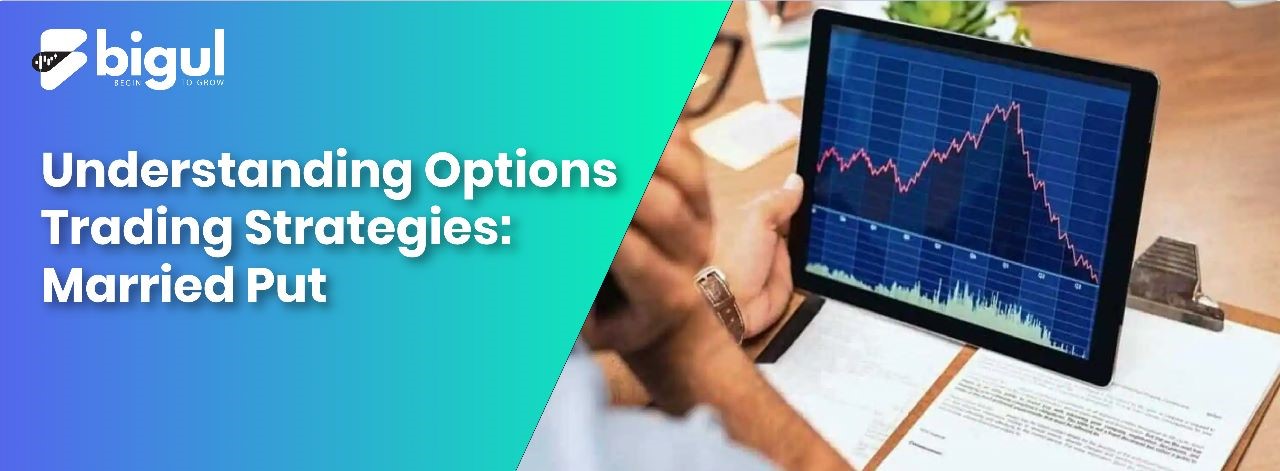Are you interested in options trading but unsure of which strategies to use? If so, understanding the married put strategy could be a game-changer for you. This trading strategy is designed to protect you against market downturns while allowing for potential profit. By combining the purchase of a put option with the underlying asset, you can mitigate your risk exposure and potentially increase your returns.
This article discusses the married put strategy, its pros and cons, and when to use it.
Also Read | Understanding Options Trading Strategies: Synthetic Put
What is the Married Put Strategy, and how does it Work?
The married put strategy is an options trading strategy that involves buying a put option and the underlying asset simultaneously. This strategy protects against market downturns while allowing the investor to benefit from potential price increases in the underlying asset. The strategy is called “married” because the ownership of the underlying asset and the put option are coupled.
Let’s understand this with an example. Suppose an investor purchases 100 shares of a stock at Rs 500 per share and is concerned about a potential market downturn. They buy one put option at a strike price of Rs 480 for Rs 10. If the stock falls, the put option will rise, offsetting share losses. If the price increases, the put option expires worthless, but the investor gains from the stock’s appreciation.
Components of Married Put Strategy
The married put strategy involves purchasing a put option and a corresponding underlying asset. This strategy protects investors from losses while letting them profit.
The key components of the married put strategy are:
- The Put Option: A put option is a financial contract allowing the holder to sell the underlying asset at the strike price on or before the expiration date. This lets the put option holder sell the underlying asset at a specified price even if the market price has fallen below that figure. By purchasing a put option as part of the married put strategy, investors can protect themselves against potential losses in the underlying asset’s value.
- The Underlying Asset: The underlying asset is an essential component of the married put strategy. It is the thing the owner wants to keep safe or make money from. It might be a stock or ETF. The put option’s value depends on the asset’s price, and if it falls below the strike price, the investor can sell it for a fixed price. The underlying asset’s price movements are critical in determining the success of the married put strategy. Therefore, investors must carefully pick the underlying asset depending on their investment goals and risk tolerance.
- Buying and Selling: To execute the married put strategy, an investor must simultaneously purchase the put option and the underlying asset. This indicates the investor is buying insurance against asset value declines. If the asset’s value falls, the investor can sell the put option at the strike price, limiting losses. If the asset’s value rises, the investor can benefit by selling it. However, Investors must consider the high expense of adopting the approach.
Advantages of Married Put Strategy
The married put strategy is a popular options trading strategy that offers several advantages to investors. Some of the key advantages include:
- Protection Against Market Downturns: The married put strategy offers downside protection by allowing the investor to purchase a put option as insurance against a decline in the underlying asset’s value. This can help limit potential losses in a market downturn.
- Reduced Risk Exposure: By purchasing a put option, the investor limits their potential losses, as the put option provides the right to sell the underlying asset at a predetermined price. This can reduce the risk exposure of the investor.
- Profit Potential: Married puts can benefit in bullish and negative markets. While the put option protects against losses, the investor benefits from the asset’s price rise. If the asset price lowers, the investor can sell the put option for a profit.
Disadvantages of Married Put Strategy
Married put strategy can provide investors with several advantages. But It also has several disadvantages that investors need to consider before implementing it.
- Cost: Buying a put option costs money, which might diminish the strategy’s potential returns.
- Limited Profit Potential: The strategy has limited profit potential as the investor has a capped gain due to the cost of the put option.
- Requires Careful Monitoring: The strategy requires careful monitoring of the underlying asset’s price movements and the option’s expiration date. If the asset price does not move as anticipated, the investor may need to make adjustments or exit the strategy, which requires active management.
When to Use Married Put Strategy?
The married put strategy is most suitable for investors who own stock and are concerned about potential downside risk. It’s especially important when the investor is unclear of the market’s direction, or a major market crash is possible. In such scenarios, the married put strategy can provide a level of protection by limiting the investor’s downside risk.
The married put strategy may be used when an investor has a short-term bullish outlook on a particular stock but is still concerned about potential downside risk. The strategy provides a means to participate in the potential upside while limiting the potential downside.
However, the strategy is not suitable for all investors. It requires careful monitoring and may involve additional costs, such as the cost of purchasing the put option. As with any investment strategy, investors should carefully consider their financial goals, risk tolerance, and investment timeframe before implementing the married put strategy.
Wrapping Up
Understanding the married put strategy can be valuable for investors seeking to protect their portfolio against market downturns and reduce risk exposure. While it may come with some limitations and costs, the potential benefits make it worth considering for the right market conditions and investor profile.
Also Read | Understanding Options Trading Strategies: Protective Put







.jpg)
.jpg)
